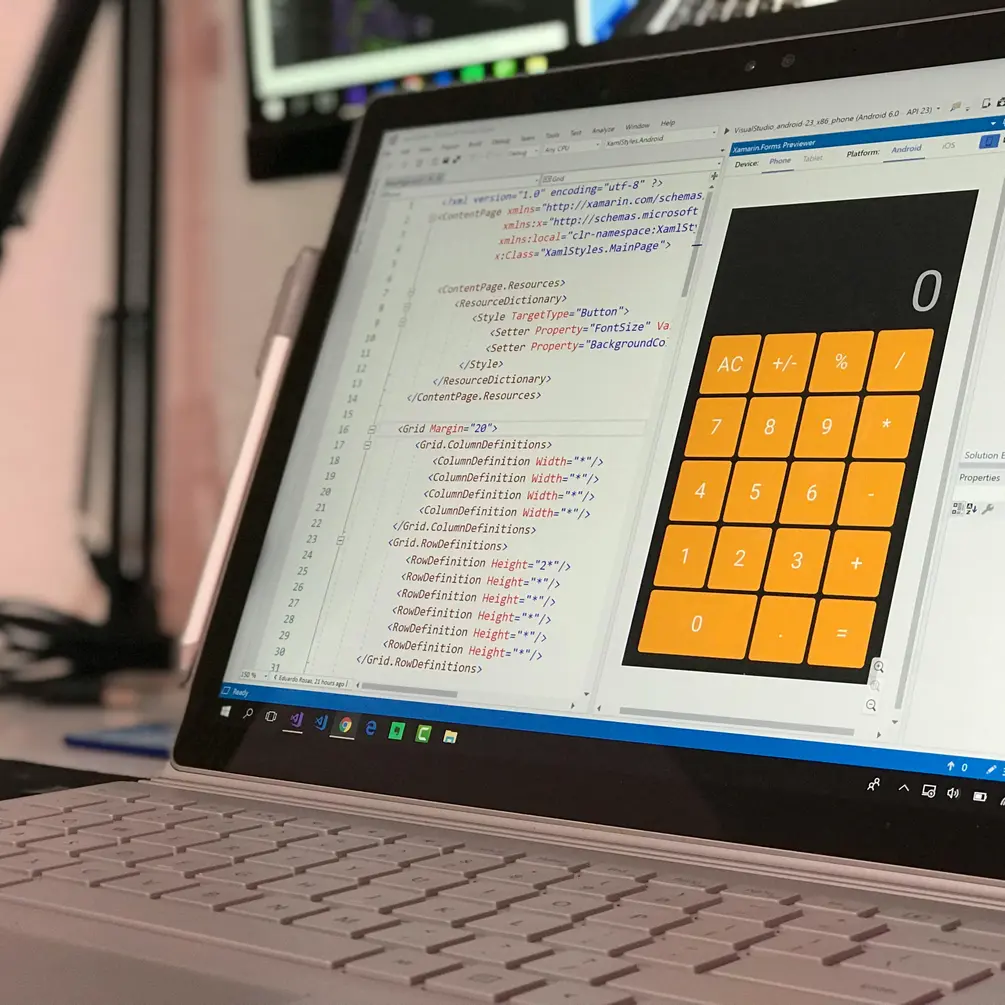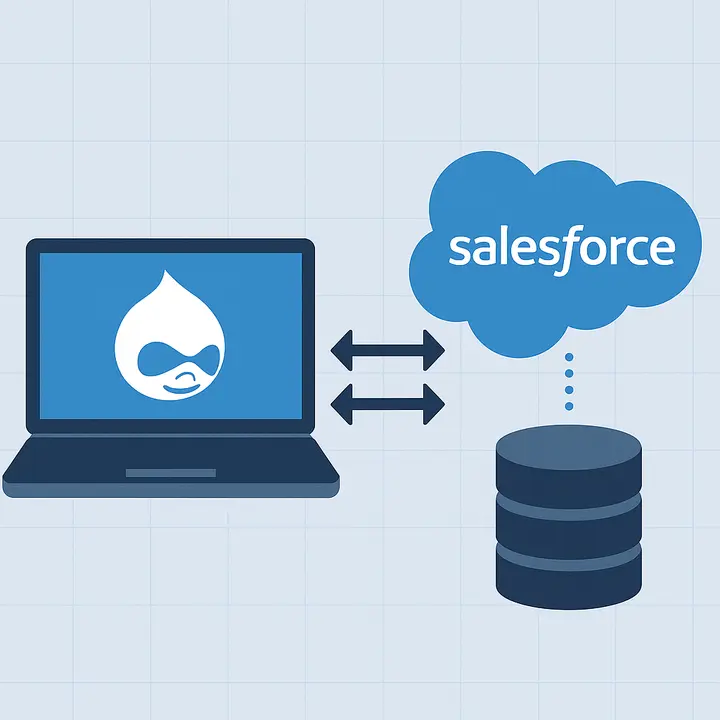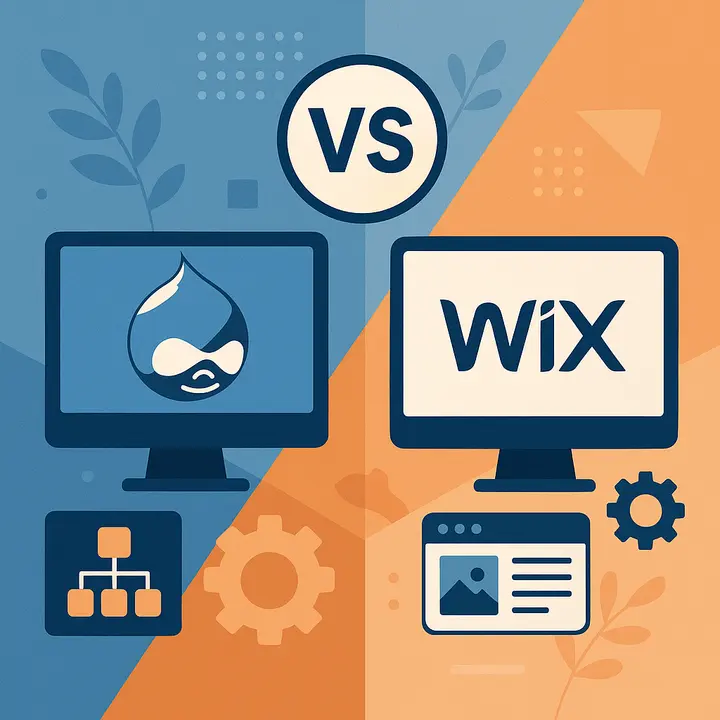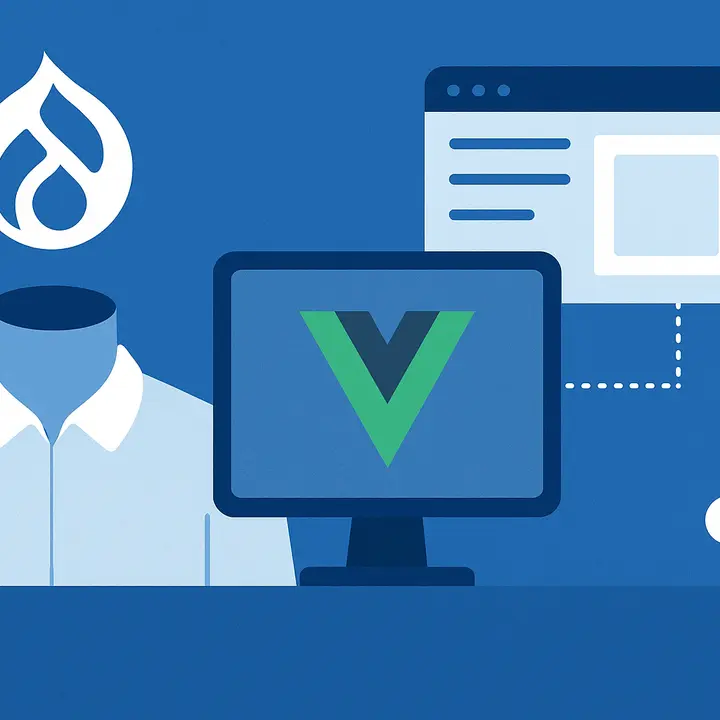Top 10 Factors That Affect Mobile App Development Cost
The price for mobile application development depends on a number of factors. Understanding the key factors that influence the cost of the project is absolutely crucial if you want to make more cost-effective solutions, plan a budget, and actually get a return on development. Let’s review the principal 10 factors that impact the overall price for mobile app development.
Type of application
Simple as it is, the cost for an app development project is defined by its type, as usually, a specific type requires a predefined set of features and functionalities. Each app category has various criteria, such as expected traffic, core functionality, security, and third-party integrations, that affect the project’s scope. Let’s discover the average pricing for mobile app development based on its category.
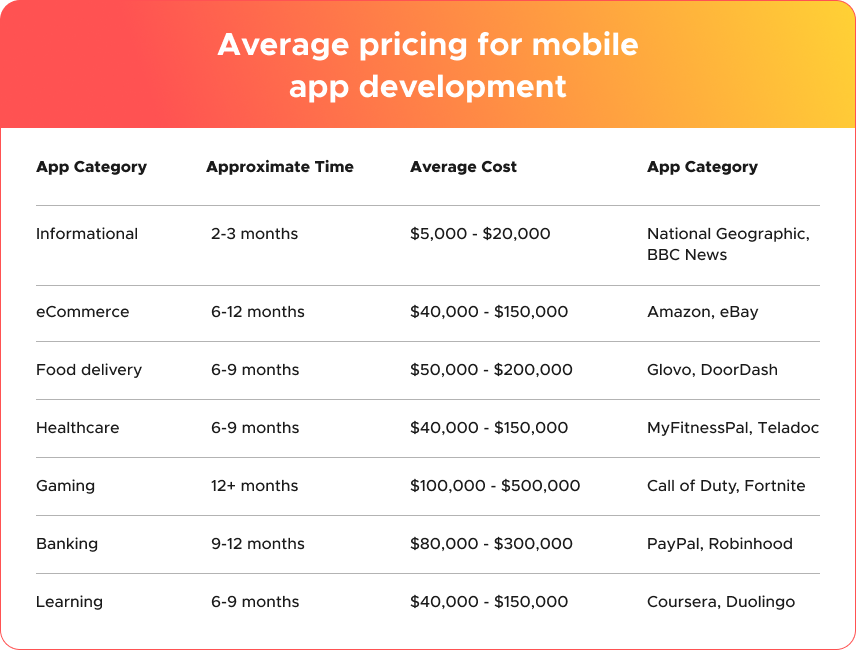
Don’t see your app category in the list? Talk to our experts and receive an estimate on your mobile app development project.
App Complexity
App complexity is one of the biggest determinants of cost. Creating basic applications typically requires 2-3 months and ranges in price from $10,000 to $100,000. The budget for developing medium-complexity apps typically falls within the range of $100,000 to $200,000. The price range for creating intricate applications typically falls between $200,000 and $300,000 or more. Here is a more clear break-down:
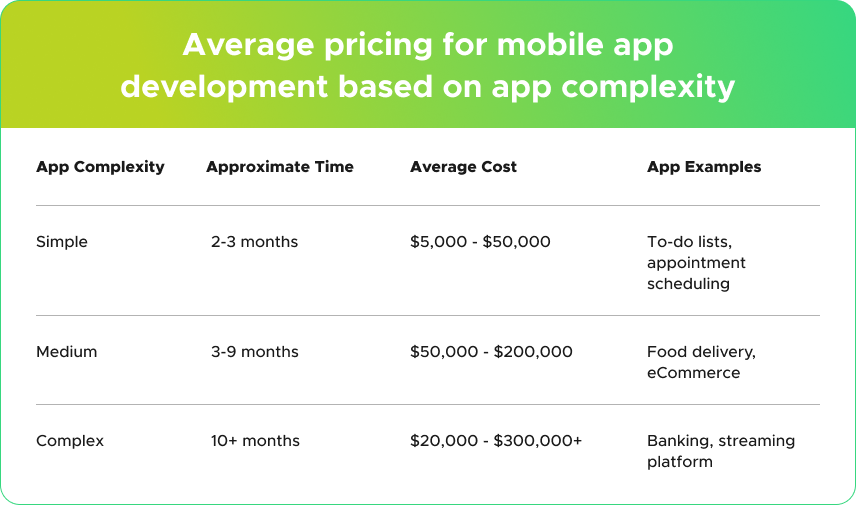
Platform Choice
When starting the project it is crucial to research your industry and target audience in order to understand which platform will bring you the most revenue. The choice of the specific platform the app will run on significantly influences the project’s timeline and cost. Each solution has its own requirements. Here are the most popular platforms for you to choose from:
- Native: Native apps are built specifically for a single operating system like Android or iOS with the help of tools and programming languages native to that operating system (Java, Kotlin for Android, Swift, Objective-C for iOS). Such an approach offers the best performance and provides access to device features like a camera, notification system, and GPS. However native application development is the most expensive and time-consuming model, especially if you want to target both operating systems.
- Cross-platform: Thanks to cross-platform app development, you can target multiple platforms (Android, iOS) with a single app’s codebase, that usually requires zero or minimum modifications. Frameworks like Flutter and React Native allow developers to write a single app and launch it across various platforms. Although this approach is more budget-friendly, it has limitations in accessing native device features and has worse performance optimization compared to native development.
- Web app: A web application is a responsive website version that behaves like a mobile app but runs in a browser. Unlike native or cross-platform solutions, web apps don't need to be downloaded on the device. Such solutions are always faster and cheaper to develop, especially when you already have a website. They are typically built with technologies like HTML, CSS, and JavaScript.
- Hybrid: Such applications combine the elements of both native and web apps. They are developed with the help of technologies like HTML, CSS, and JS but wrapped in a native shell, meaning they are available via app stores. Although they allow some access to device features, their performance is worse optimized compared to native solutions.
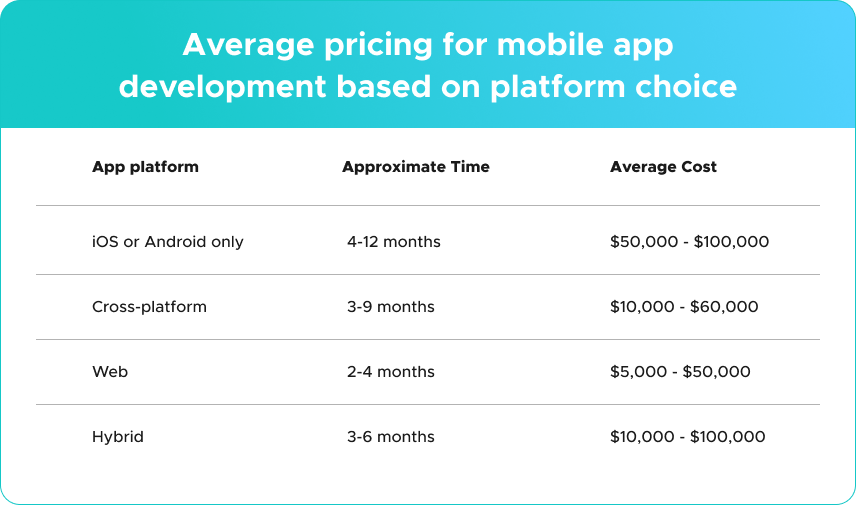
UI/UX design complexity
The next point that impacts app development cost is design. The user experience (UX) and user interface (UI) of a mobile app can be basic or advanced, depending on the number of custom animations, transitions, and user flows. A well-designed app enhances user engagement but also increases development time and cost.
There are two main options for app design: Custom and Standard UI. Custom design is more complicated to implement while in standard design you can use pre-built templates and interfaces. The other design stages that influence the cost of prototyping or wireframing and animation.
- Prototyping (Wireframing) is the process of creating a visual blueprint of the app’s layout and structure. It involves drawing simple, low-fidelity sketches or digital mockups that represent the skeletal framework of the user interface (UI). Wireframes focus on the functionality, navigation, and overall user experience (UX).
- Animation is the use of motion to enhance user interactions, improve user interfaces, and create more engaging user experience.
Apps like Google Keep use basic designs, keeping costs low. More customized designs, like those in Tinder, involve swiping features and animations, making them more expensive. Below, you can see a cost breakdown of each design stage:
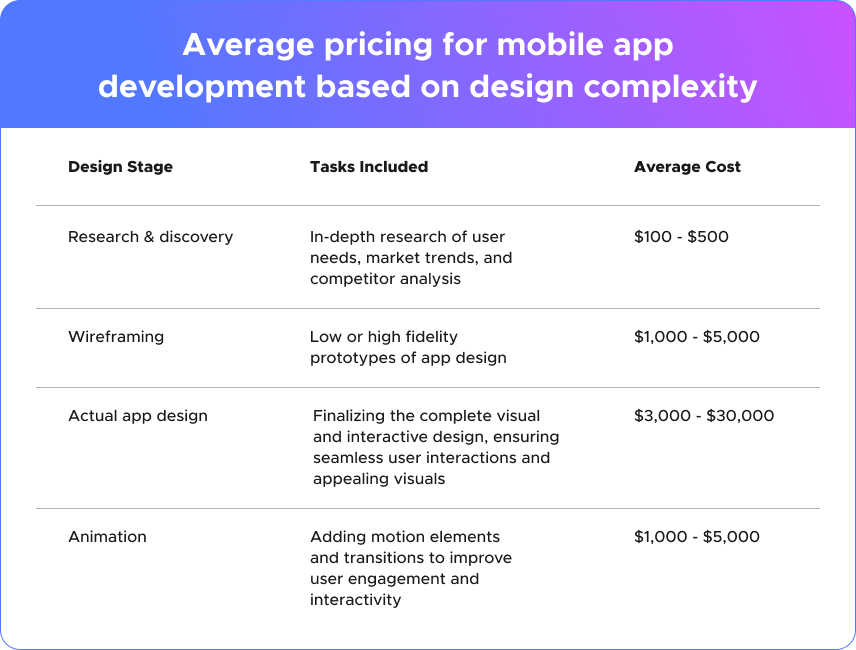
App features and functionalities
The features and functionalities embedded in the app play a paramount role in determining the final cost. Common features include user login, social media integration, payment gateways, geolocation, etc. The more complex the features, the higher the cost. Apps like Uber or Google Maps use geolocation tracking extensively, which increases their development costs. Adding features like live chat and video streaming also significantly raises costs.
Third-party integrations
Many applications rely on third-party integrations. Such integrations allow apps to connect with external services, including but not limited to payment gateways, social media logins, cloud storage, or analytics tools.
Dev team expertise and location
The costs for the mobile development project heavily depend on the development team’s expertise and location. It’s not a secret that offshore software development companies from Eastern Europe offer significantly reduced hourly rates compared to the USA or Canada for the same scope of work and expertise. Besides, developers might have various levels of experience (junior, middle, senior) which also influences the hourly rate. Unlike development team location which provides zero change to code quality, the dev’s level of expertise can significantly influence the outcomes. We highly recommend opting for middle or senior app developers for your project.
Here are the average hourly rates for app developers by country:
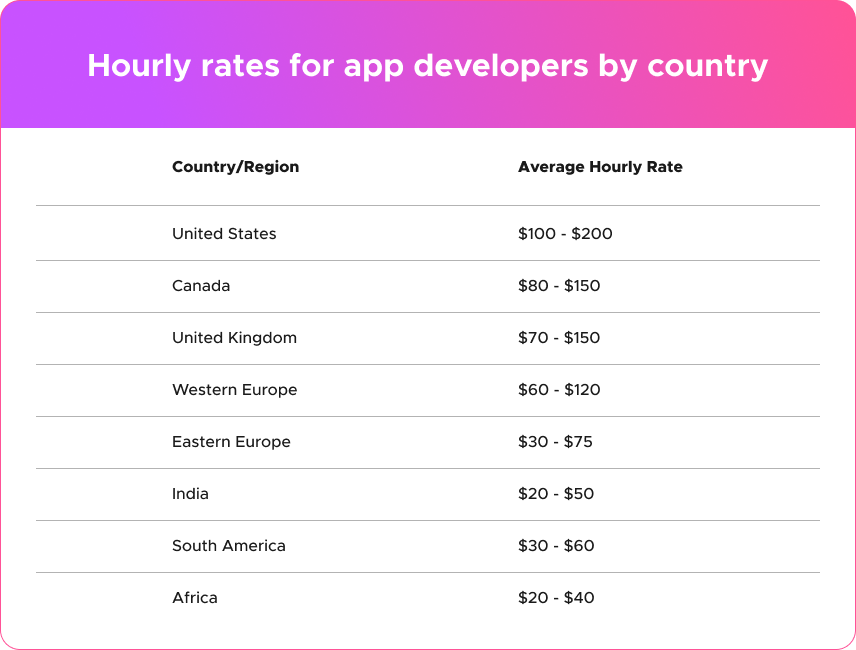
Having hubs strategically located across Canada and Europe, our developers are available for both nearshore and offshore outsourcing projects. Check out our guide on offshore software development to learn everything you need to know about this type of IT outsourcing.
Scalability needs
When starting an app as a startup you need to take care of the platform's scalability in advance, so you don’t have to redo everything from scratch as your business grows. Applications that expect significant traffic growth and functionality enhancements in the future require a well-structured and well-thought architecture scalable for development and improvements later on. More complex architecture requires more resources for its research, design, and development.
Security measures
Web security is a paramount concern for all business owners worldwide. Applications that store sensitive user data, such as health records or banking operations should take security seriously. Hacker attacks and malicious code injections bug the website and application owners all over the globe, causing harm, data leaks, and data loss. Investing in security planning and implementation from the beginning might save huge amounts of money in the future.
Examples of security measures you can implement are basic encryption, data encryption, two-factor authentication, biometric authentication, regular security updates, and more.
Smart technology
Incorporating smart technologies into your mobile application is the most expensive aspect due to its complexity and the level of expertise required. Smart technologies are features like Artificial Intelligence (AI), Augmented or Virtual Reality (AR/VR), Machine Learning (ML)., blockchain, and Internet of Things (IoT).
Artificial Intelligence
AI-based applications use AI algorithms to provide smart functionalities such as voice recognition, personalized recommendations, predictive analysis, and more. Artificial Intelligence features make apps more creative, personalized, and competitive. Integrating AI into a mobile app requires specialized expertise, as well as an extended timeline and budget.
- Cost Estimate: $20,000 - $100,000+ depending on the complexity and AI features.
- Example Features: Chatbots, personalized content recommendations, facial recognition.
Augmented/Virtual Reality
AR/VR is a new trend not only in the gaming industry but also in eCommerce, retail, and beauty segments. With the help of digital overlays developers can create virtual try-ons for clothes, home decorations, and makeup & beauty products, allowing users to visualize how products will look in real time. Such technology integration requires advanced graphics, hardware integration, and 3D visuals.
- Cost Estimate: $30,000 - $150,000+ based on the level of immersion and interaction.
- Example Features: AR navigation, virtual try-ons, VR gaming experiences.
Machine Learning
Another revolutionary technology is Machine Learning, which enables apps to automatically learn from users’ behavior and interactions and improve themselves. ML involves the creation of custom modules and pre-trained algorithms.
- Cost Estimate: $20,000 - $100,000+ depending on the data complexity and algorithms used.
- Example Features: Personalized search results, predictive text input, speech recognition, fraud detection.
Blockchain
Blockchain is the new trend in web security and payment decentralization, making it a top choice for financial apps, cryptocurrency platforms, and apps designed for secure transactions. The complexity of blockchain implementation requires skilled developers and extensive expertise in this industry.
- Cost Estimate: $30,000 - $200,000+ depending on the complexity of the decentralized system and security requirements.
- Example Features: Secure payments, digital wallets, decentralized apps (dApps).
Internet of Things
IoT apps connect with physical devices through the internet to control and monitor systems remotely. To build an IoT-powered mobile application, you need to hire developers with an in-depth understanding of hardware technologies and data processing.
- Cost Estimate: $30,000 - $150,000+ depending on the number of devices and sensors integrated.
- Example Features: Smart home controls, fitness trackers, remote monitoring systems.

